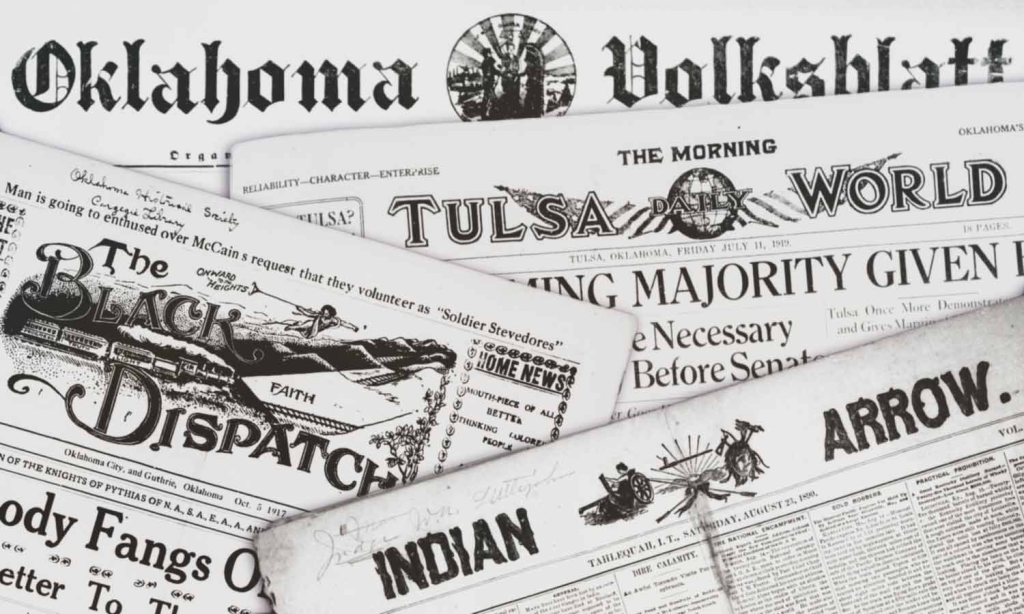Posts Tagged ‘Genealogy’
Newspaper Digitization Project
Chickasha Public Library’s collection of newspapers on microfilm has been digitized and is now freely accessible to the public on the Gateway to Oklahoma History.
The Chickasha Public Library was awarded $20,000 through the Oklahoma Heritage Preservation Grant Program provided by Oklahoma Historical Society. In addition, the Friends of the Library contributed $3,700 towards the total cost of the project. This money paid for the cost of digitizing 473 microfilm rolls containing Chickasha newspaper records from 1923–2018. The newspapers are now hosted on the Gateway to Oklahoma History for public access.
The goal of this project is to preserve Chickasha’s history and to make that information more easily accessible. Previously, the Library’s newspapers records were on microfilm and could only be seen by one person at a time. Digitization allows that same information to be shared widely. Instead of scrolling through images on a microfilm screen, people can now access this information from any device with internet access. Computers with internet access are also available to the public at the Chickasha Public Library. Searching on the Gateway can be done by collection, date, keyword, or location, which makes it very efficient for anyone looking for relatives’ obituaries, specific articles, or who want to browse for information about a particular person, event, or topic.
The Gateway to Oklahoma History contains thousands of Oklahoma newspapers, photographs, postcards, and more. It is a great resource for researching local history, genealogy, or simply browsing through the items. Searching can be done in a variety of ways, and newspaper images can be easily enlarged, cropped, modified, and downloaded. This allows anyone to customize their searching and reading experience to reflect individual preferences.
According to Michelle Skinner, local newspapers are valuable resources for learning about the past. “The information contained within these newspapers gives a glimpse into everyday life in Grady County. Over 90 years of history have been preserved through digitization and are now freely available and searchable.”
Because Chickasha newspapers from before 1923 are already on the Gateway, this addition completes the online narrative record of Chickasha’s history and ensures that the information is preserved in a format that is both user-friendly and accessible to the public.
How I learned to Knit. What does the library have to support your hobbies?
Back in the Dark Ages, 1997, I found a pair of knitting needles in my mother’s big blue sewing box. Why there were knitting needles in there, no one knows, she was an avid crocheter, but I had never seen her knit at that point in my life. I took them as my own and decided to learn to knit. The problem? 1997 was pre-internet, and I didn’t have a knitter handy to help me. What did I do? Why I turned to the only resource, a teen in rural Oklahoma had–the encyclopedia. Yep. I grabbed the “K” volume, a skein of Red Heart, those found needles, and got to work trying to learn the art/craft/sorcery that is knitting.
A book that may have been a bit more helpful than a half-page entry tucked between the Knights Templar and Alfred Knopf in an out-of-date World Book would have been a comprehensive guide like Knitting school: a complete course. This book addresses the basics of knitting and how to fix mistakes like dropped stitches. It even has simple patterns for basics like mittens and baby booties.
Of course, knitting isn’t the only hobby a person could enjoy. The book Get a Hobby: 101 All-Consuming Diversions for Any Lifestyle lists, well, 101 hobbies that you could learn. And the library has resources to help you with many of them.
With the rise of at-home tests, genealogy has exploded in popularity. Did you know that the library has access to several resources to trace your family history? You can start your search from home by logging onto HeritageQuest. You can search for your relatives in city directories, the US censuses as late as 1940, even Freedman’s bank record. HeritageQuest is available from home on our e-resources page. You can also access several physical items at the library to help with your genealogy quests, including yearbooks.
Perhaps you want a hobby more tangible than genealogy but less tangled than knitting. Papercrafting could be for you, and Origami isn’t your only option either! There is Kirigami: the art of 3-dimensional paper cutting by Laura Badalucco. Kirigami is a combination of folding and cutting paper to create images that “pop” from the page. You could use this skill to make amazing birthday cards and jaw-dropping displays for your home.
In the end, World Book served me well enough, and if you like an encyclopedia, those are available at the library. I learned the basics of knitting from an encyclopedia, even if that first scarf was a mess of dropped stitches, crooked edges, and uneven tension. Over the years, I have used many resources, mainly from the internet, to learn new techniques and patterns, but I will always be on the lookout for a good book that will help me grow my hobby.


